Pondering VH’s Fair Warning Tone
LOVE the first four Van Halen albums. Always have, always will. Love the rest too, including the Van Hagar years (oops, forgot about VH III…), but those first four vinyl donuts are to me and many others just the nads. The nadliest of nads.
They’re a band kicking the world’s butt in every way, and it shows.
Anyhow, tone-wise seems like most Ed Van Halen fans are bent on copping the larger-than-life, comet-hitting-the-Earth-from-outta-nowhere first-album tone. I get that, but it ain’t my favorite.
The Van Halen II tone – much different – is great too, the over the top tone raspy on Women and Children First likewise, and then we come to what I think is the hardest, meatiest, nad-kickin’est guitar tone on any Van Halen record: Fair frickin’ Warning.
And here’s the thing: It’s the most difficult to cop. Or can be. Or maybe so many guys are focused on nailing the first album tone that the other four tones have gotten shoved aside.
Some folks have gotten close to the Fair Warning tone with the base components of any early VH tone chase: Marshall plexi or plexi-like/clone amp, and low-efficiency Celestion speakers (e.g., Greenbacks), along with any number of pickup and geetar wood combinations.
Talkin’ real tone here, not modelers, computers or whatever. Kinda like:
But not me…yet. Haven’t gotten real close. Maybe you’re in the same boat. Before going into that, a couple disclaimers:
> Tone is in the ear of the beholder. Your Fair Warning tone might not be the same one I’m hearing.
> It’s possible that Ed used the exact same setup he used on any of the four albums and it’s all recording magic. We don’t know for sure exactly what was used on any of those albums, including Fair Warning. You can say you need this or that tube or pedal or pickup or body wood, but talking here about COPPING that tone, not REPLICATING it – which you gotta admit is pretty much impossible. You’d have to have Ed’s hands, the board, studio magic, etc.
> Forget the supposed importance of the Eventide Harmonizer that first makes its wet appearance on Fair Warning. Yes it’s there, yes it affects the tone and yes you can get all you need in that department (and all subsequent VH) from the stellar Eventide PitchFactor pedal. But this is about the core tone.
Here’s what I’m hearing that’s different from the first three albums:
Buzz
Aka hair, distortion, whatever. It’s there. It’s there on Women and Children First too, but that sounds more like the blue MXR 6-band EQ-type buzz. Fair Warning to me sounds like a hotter pickup.
Some say they think he used the “normal” EVH lower-output or hot-wound PAF-type pickup (I best Ed changed stuff practically every day), but I think it’d be tough to cop that tone with such a pickup. To my ears Fair Warning has some “razor” and some sustain that aren’t just from a Marshall with 6CA7 power tubes on 10. It’s a DiMarzio Super Distortion or something more along those lines.
Actually, the vid above is a good example of a great core tone – through one of the best plexi-style amps ever created by man, the Metropoulos ’68 Super Lead replica. But it lacks that razor, sustain and a little hi-fi you can get from higher-output pickups.
Is said hair from the Variac cranked up like Ed says he did but everyone now acknowledges is unwise and dangerous…not that that ever stopped him before? Don’t care. I’m not messing with a Variac. I want to plug in and play.
Balls
Aka lower mids. Ed’s tone always has the characteristic Marshall high mids though in a more-musical way than many plexis are able, but Fair Warning also has BALLS – Bogner Shiva-like balls.
Unusual, and it may be where some of the “dark” label comes from that folks like to slap on Fair Warning.
To be clear, the FW tone has the clanking plexi/6CA7 upper mids AND the balls. Now that’s an amp I’d buy in a hot second.
Fatness too, some of which is the Harmonizer, but also from the lower mids.
Is it the speakers? Mebbe, but I doubt it. Is it, as some have claimed apparently with no proof, Gibson Les Pauls suddenly used on this album? Doubt it and again, no proof. Is it studio EQ? Possibly, maybe probably, but doesn’t matter. I want to cop that tone live, mang!
_____
The best way to hear the hair and balls (hair and balls?) is in the Mean Street iso track (ripped from Guitar Hero), but I couldn’t find it online so here’s Unchained a decent example:
_____
What Does This Mean?
Here’s the iso track from “Hear About It Later” off the same album. Supposedly the rhythm track was a Strat. If so, that’s one ballsy Strat tone…but to my ears it’s not as ballsy or hairy as the humbucker tunes – and you can hear the humbucker punch in and out on this track:
So Where Are We Now?
Okay maybe not “we,” but where I am now on the Fair Warning tone-copping recipe is this:
- Plexi-style amp, ideally 100w (more balls) with 6CA7 tubes (for clang), but a 50w with EL34s will work too.
- 4×12 with good Greenbacks and maybe some Blackbacks worked in for more vintage VH, though a 2×12 may do it…maybe.
- Lower mids boosted (EQ or…?), unless Santa has a deal with Reinhold Bogner….
- Higher-output pickup, like: a Super Distortion or similar DiMarzio, a similar Duncan, or a custom wind.
Try it EVH-heads and fellow Fair Warning fans, lemme know. I’ll do the same and report back here.
Category: 6CA7, DiMarzio, Edward Van Halen, Marshall

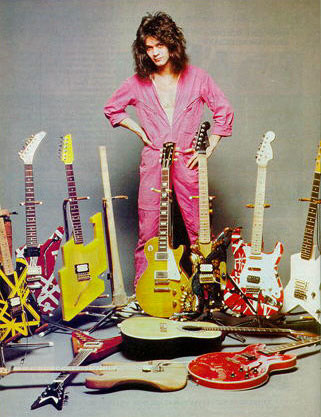




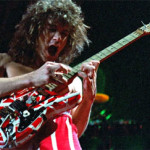
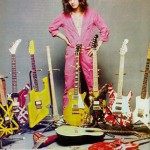
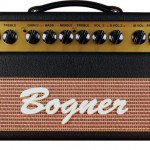
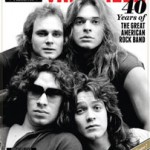
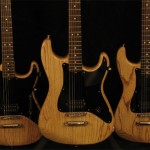


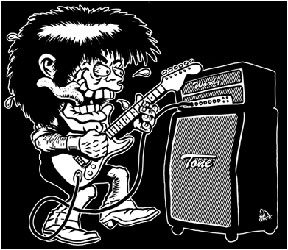

Which songs did he record with the pickaxe?
One crucial thing that I’ve heard but can’t verify is that Ed recorded Fair Warning with the Floyd Rose system, which he hadn’t done before–his specific reason being that he didn’t like the bright tone of the bridge and nut. It would be a major factor if he made his peace with that tone and figured out how to work with it. (Creative EQing?) Anything the strings touch directly is going to have a dominating effect on the tone.
I would also bet on the DiMarzio style pickup. Listen back to VH1 and compare the Ibanez songs with the Frankie songs. The ones recorded with the Ibanez sound hairier and a little more bottom-heavy, whereas the Frankie ones have that smoother, chewier sound that people usually associate with classic Ed. It’s not as dramatic a difference as there is with Fair Warning, but it’s audible.
I don’t think the studio played a major role in this tone. Listen to the ’81 Oakland shows or any bootleg from that tour (LA Forum comes to mind), the tone is there so he was able to get it live. I do think the harmonizer played a significant role. Likely though it has to do with a hotter PAF-type pickup but if anything I think he turned the Variac down slightly. I’ve tried this with a Les Paul and gotten closer to the Hear About It Later tone. Then again, I never had the balls to turn the variac up. Ed took a few new guitars with him on the FW tour and they had a single humbucker so I don’t think the Strat is the solution. A final point which I have never heard mentioned and I am probably totally off base with is that to me it “feels” like he is using heavier strings on Fair Warning, at least on the rhythm parts.
Been listening to Fair Warning quite a bit lately myself. I agree w/most of your speculation because I play a 50w non-mv, inefficient speakers, overwound strat pups…and an airbrake attenuator.
Anyway, you said this: “clanking plexi/6CA7 upper mids AND the balls. Now that’s an amp I’d buy in a hot second.” That would be a 50w Traynor YBA-1 with 6Ca7s, original phillips 12ax7s, tube rectified. Bass balls for miles with the dial maxed. Through a Rangemaster clone in front, and hear it sing.
The perfect pickup for the Fair Warning tone is the Seymour Duncan Custom Custom (SH-11). In fact, it’s rumored that is the pickup EVH used on his 5150 guitar (Seymour made that pickup for him).
Tube bias plays a significant role in the “Brown” sound. I run my EL34s cold now, rather than hot for an authentic Brown/EVH tone. Consider this: Eddie intentionally designed the Peavey 5150 to have a fixed, cold bias with crossover distortion. Many tubeheads dismissed this as a flaw in the 5150 design. Ed also used big bottle Sylvania 6CA7s which were more readily available & less expensive (at the time) and cooler. Add in what Ed was doing with the Variac, and considering his experiments along his entire signal chain (pickups-pedals-dummy loads-amp slaving), then cold biasing makes sense.
The “secret” of the new Marshall YJM100 is that is more the Early EVH amp then Yngwie’s IMHO. The Electronic Power Attenuator, reverb, and judicious booster settings absolutely nail the early EVH Brown Sound (with the right guitar). Throw in a script Phase 90, phaser & delay and you’ll be covering VH like never before ;)
if you search for it you will find it…there was an interview with Ed’s guitar tech after release of FW. He said that they ab’d several cabs for this album and chose the one with g12t-75’s in it (80’s Marshall cab). That totally explains the added tightness, added lows, crispier highs.
Cool! Where did you read that? Need the exact source please!
I read it in one of the guitar publications…might have been Guitar Gear mag. The pic in the artical showed the back of an eighties cab with some of the vinyl burned off. Can’t find the article so far. After I posted that…I searched high and low for the article…I will keep looking.
The other thing that no ones seems to talk is the tube mic pre and compression that is being used on VH1. The sucker is compressed big time…you can really hear it on “Runnin'”
Hello! First of all: EVH used a Variac to LOWER the voltage to 89 V. That way he could crank the amp without blowing a fuse every gig.
The Marshall was used as a pre-amp only. EVH built a simple power soak, ran the signal through a flanger and an echoplex, into an H/H 2×400 W solid state power amp and into a marshall 4×12 speaker.
VH II is the exception of the early albums – that’s just regular marshall all the way. And you can hear that the sound is more midrangy and “normal”. Still a great sound, but not “divine”.
The “proof” is in the pronounced flanger effect. If you put the flanger between guitar and an amp running hot, the flanging effect will be much more discreet. The echoplex on Eruption is also post-distortion (otherwise it would be terribly muddy), and you can hear that it’s not delay added in the mix.
There is no way you can get the chainsaw articulation of “Ain’t Talkin’ ‘Bout Love” without the solid state power amp. You can get close, but power tubes and output transformers will always round off the sizzle characteristic of EVH’s sound.
This is somewhat right but mixed up a bit. Check out the Metroamp.com EVH forum if you haven’t already, it will explain ALL!
I got this e-mail from a friend’s friend:
“I can go into detail about the Eddie Van Halen method of loading the amp then driving the effects and echo at line level into a power amp (he used H&H power amp) then into 4 paralleled cabs into 4 ohms.
I’ve seen it with my own eyes and heard it from the horse’s mouth!!
The setup is a 100 watt Marshall plexi with Sylvania 6CA7’s. The head is plugged into a Variac to lower the mains voltage to about 90 VAC or whatever he’s in the mood for. This browns the sound slightly and helps lenghten the tubes’ life. The speaker out is set at 8 ohms. The dummy load resistor is adjusted to about 20 ohms. Then the load resistor is tapped at center and sent to a box with a potentiometer in it and and output jack. The output jack is a line-level low-impedance source and will not muddy up the tone anywhere. The pot. is adjusted for whatever drive level you want. It then goes into the MXR Phase 90, MXR flanger, and Echoplex-EP3. This then goes to the power amp, usually a low-powered one, 100-200 watts. This is to prevent fucking up good real low-power vintage speakers, as opposed to today’s higher-powered shit Celestions. The final power amp he used was by H&H and he paralleled 4 cabinets down to 4 ohms to connect it to power amp. This IS the setup for his early days. Nowadays it’s a chorousy-sounding pile of buzzy horse shit!
The reason why the load resistor is set higher than the selected impedance of the amp selector is because a 100 watt Marshall head at full volume into a resistive load set to the same impedance as the head will put out way over 100 watts, try 160-180 watts. This is because the amp will go into class B mode. When a cabinet is being played at full volume its impedance climbs, especially higher if it is a sealed closed back cabinet. This higher load tends to keep the amp at around 100 watts. A head played into a resistor of the same value will fry the primary windings of the transformer due to the excessive A.C. currents. So increasing the load resistor by at least twice sort of keeps the A.C. currents in the range that the output can deal with, at full volume. This does not muddy the sound. After the potentiometer, it is low impedance source and can drive the effects with no problem. That’s why his flanger had so much of a strong effect. The Echoplex is quiet in this setup. If you were to connect a EP3 Echoplex in front inputs to a 100W Marshall on full volume, the noise and hiss levels would be insane.
I hung and partied with this guy for years. He even told me about his guitar: the body is from a 65′ Strat he use to play at the Whiskey A Go Go and is Alderwood. The necks were from all over, some from Mighty Might and some from old Charvel and some from who knows where. The pickup is from an early sixties 335 and was dipped in Dr. Zogg’s Sex Wax. This is surfboard wax that he melted in a coffee can and potted his pickup in. This is probably the key to his sound. Since the capacitance of the pickup was increased a lot, it will brown the sound, roll off the highs and will also be more distorted sound. His amp itself was dead-stock. The person who introduced him to this amp setup was Jose Arendondo.”
I see no reason to doubt the contents of this mail. The solid state power amp is the missing link. The genius of EHV is all the tinkering – nothing is stock! I also heard that on VH I the cab was loaded with 2 Celestions & 2 JBLs.
A Quick note on Variacs!
The quick simple explanation. I hope!
The one thing that always gets left out in these forums is the electrical principal involved with dropping the voltage.
Which IS what Eddy did.
Watts is what actually does the work in an electrical circuit, which is Volts x Amps = Watts
Anytime you drop the voltage in a circuit, you WILL raise the Amp draw to make up for it, as that appliance has to have xxxx______Watts to run.
Most people know that when you raise the Amp draw you create much more stress and heat on the wire sizes, Components, etc.
YES, if there is a lack of Watts you will create a brownout!
But first you will heat the hell out of things when the Amperage raises trying to make up for the lack of Volts.
I realize this is not a full THEORY explanation for those w/o extensive electrical knowledge, and that there are lots of variables involved etc.
But hopefully this gives a real brief insight to what you’re causing by doing this. So, unless you know how to do your own amp repairs, I would stay away from variacs – but if you do your own amp repair, you probably already know this.
For those that don’t, hopefully this will save you some grief, and give you a quick insight in to what’s happening w/ a variac!
Hope your day Rocks – Have a good one!
>> “I see no reason to doubt the contents of this mail. The solid state power amp is the missing link. The genius of EHV is all the tinkering – nothing is stock! I also heard that on VH I the cab was loaded with 2 Celestions & 2 JBLs.” <<
As far as the H&H Power amp being "the missing link", I wouldn't consider it to have any appreciable affect on tone, as it is Solid State and is there to amplify the already shaped signal without coloring it further, just as a quality Solid State Hi Fidelity Stereo amplifier should. The biasing of the 6CA7 tubes has been long overlooked, except by Ed himself. Everyone has assumed for years that he biased them hot. I think the evidence points to the opposite. As far as his José mod, I'm also convinced that this is simply an internal channel jump and nothing more. Ed's techs have hinted at this and Ed has always been very coy about it.
Cheers!
A solid state power amp driving a 4 x 12″ cab sounds really different than tubes driving the same cab. It has to do with the output transformer. Marshall transformers are easily fried – that’s probably why they sound good. I have tried boutique amps with “overdimensioned” output transformers and they sound horribly scratchy. Anybody who has played a Marshall 100W on full knows that it is a pretty honky, narrow-bandwidth experience – you lose a lot of treble and bass.
A celestion speaker working close to its limits presents an inductive load to the amp (since a speaker is a coil), while a simple resistive load is an entirely different matter.
Listen to the intro of “Beautiful Girls” from VH II. That is the sound of a Marshall head driving a Marshall cab. It’s a great sound, but it’s a sound available to many good players with good gear. It is “within reach”.
Then listen to the intro of “Ain’t Talkin”Bout Love” from VH I. This is the sound of the H/H power amp driving the speakers. There’s a huge leap in bandwidth, but the treble isn’t scratchy and the bass isn’t boomy because in the signal chain there is a Marshall head on full – the difference being that the amp doesn’t have to deal with the varying impedance of four speakers.
The intros of “Mean Street” or “Unchained” from Fair Warning are other examples of solid state power amp. “So This Is Love” from the same album is probably regular Marshall, with less bandwidth. I’m just using my ears here…
The H&H was NOT used on VH1 or 2 or WACF! Again, all this has been worked out beyond most doubt at the metroamp.com EVH forum. The above email, while interesting, has to be weighed along with similar (but different!) statements from other folks who have seen EVH’s rig.
Hi admin, do you have a link to metroamp where i can find this info?
Isn’t the topic for this thread “Pondering VH’s Fair Warning Tone”? I thought that’s what we’re discussing.
The flanger gives it away. Putting a flanger between the guitar and a hot amp will give a very subtle flanging effect, nothing like the drastic stuff on “Ain’t Talkin’ ‘Bout Love”, “Mean Street” or “Unchained”. There is no flanger on VH II because there is no place to put it (the album is recorded straight, without the H/H amp). The phaser on “Light Up The Sky” is between guitar and amp (as always). The solo on “Bottom’s Up!” has a chorusing/doubling effect from the mixing console, not the guitar rig.
The tape echo on “Eruption” – where is that in the signal chain? It is definitely not before the amp – that would be a terrible mess. The Marshall doesn’t have an effect loop, and it wouldn’t really help since the power tubes are distorting, not just the preamp. I don’t think they added it the console. It was a cheap echo that EVH used live.
Yes, there is flanger on VHII. It’s in the solo of ‘Bottoms Up'(that’s not from the board), in the intro to ‘Outta Love Again’, among others, and it’s none too subtle.
I was under the impression that VHII had some flange in it… “Light Up The Sky” sounds like it has it in tons of small places when he’s chugging, and Bottoms Up sounds to me like there is at least flange on the very last note. Maybe that’s just my ears though. In my opinion, the more organic sound of VHII seems to be coming from less compression, which is why VHI seems to be bassier and thicker while VHII sounds more aggressive and woodier to me.
Woodier = different pickup, possibly different amp tweak (the mysterious white knob on back of the grail plexi). Less compression comes from that pickup, possibly studio tweaks too.
This is one of my sources:
http://www.legendarytones.com/brownsound.html
There is definitely some flanger on VH II, but it’s connected between guitar and amp, and so is the phaser heard on Light Up The Sky. The clean guitar intro on Woman In Love sounds like it’s recorded on a strat w/ singlecoils, could be any clean amp. The soloing on Bottoms Up is an outboard effect imo, chorus or pitch shift.
The solo on Bottoms Up, more than likely had some kind of Eventide processing to get that chorus sound.
If you study Ed’s concepts of amp tone, you will find that it is fairly easy today to achieve his sweet & dynamic brown sound with a number of today’s available equipment. I’ve been able to convincingly cop his fundamental tone for decades, using different combinations of pedals, rack units guitars, pickups,,amps and playing techniques. You can tweak this tone to cop any album-specific tone with ease – if you understand how Ed sees tone shaping.
The studio does have a dramatic effect on the final tone and must be part of the final equation. You can judge this for yourself on numerous “raw” isolated tracks that are on YouTube. Or, you can study the Gene Simmons demos and bootlegs from their bar days.
If you want to really ‘get’ where Ed is coming from, dig into his Peaveys & Fender 5150 amps. Ed’s concepts are at work in their designs. The underrated 5150 combo is, with proper tubes & a little tweaking, a very versatile amp that, while it is central to his post DLR tone, is the embodiment of his many years of experience. The basic 5150 design follows his roadmap from the early days of his “Frankenstein” setups.